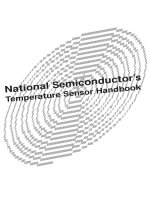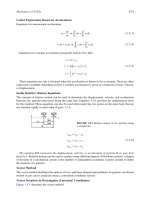albright's chemical engineering handbook
Bạn đang xem bản rút gọn của tài liệu. Xem và tải ngay bản đầy đủ của tài liệu tại đây (35.6 MB, 1,930 trang )
DK2204_book.fm Page i Monday, October 20, 2008 2:15 PM
Half Title Page
ALBRIGHT’S
CHEMICAL
ENGINEERING
HANDBOOK
DK2204_book.fm Page ii Monday, October 20, 2008 2:15 PM
DK2204_book.fm Page iii Monday, October 20, 2008 2:15 PM
Title Page
ALBRIGHT’S
CHEMICAL
ENGINEERING
HANDBOOK
Edited by
Lyle F. Albright
Purdue University, West Lafayette
Indiana, USA
Boca Raton London New York
CRC Press is an imprint of the
Taylor & Francis Group, an informa business
DK2204_book.fm Page iv Monday, October 20, 2008 2:15 PM
CRC Press
Taylor & Francis Group
6000 Broken Sound Parkway NW, Suite 300
Boca Raton, FL 33487-2742
© 2009 by Taylor & Francis Group, LLC
CRC Press is an imprint of Taylor & Francis Group, an Informa business
No claim to original U.S. Government works
Printed in the United States of America on acid-free paper
10 9 8 7 6 5 4 3 2 1
International Standard Book Number-13: 978-0-8247-5362-7 (Hardcover)
This book contains information obtained from authentic and highly regarded sources. Reasonable efforts have been
made to publish reliable data and information, but the author and publisher cannot assume responsibility for the validity of all materials or the consequences of their use. The authors and publishers have attempted to trace the copyright
holders of all material reproduced in this publication and apologize to copyright holders if permission to publish in this
form has not been obtained. If any copyright material has not been acknowledged please write and let us know so we may
rectify in any future reprint.
Except as permitted under U.S. Copyright Law, no part of this book may be reprinted, reproduced, transmitted, or utilized in any form by any electronic, mechanical, or other means, now known or hereafter invented, including photocopying, microfilming, and recording, or in any information storage or retrieval system, without written permission from the
publishers.
For permission to photocopy or use material electronically from this work, please access www.copyright.com (http://
www.copyright.com/) or contact the Copyright Clearance Center, Inc. (CCC), 222 Rosewood Drive, Danvers, MA 01923,
978-750-8400. CCC is a not-for-profit organization that provides licenses and registration for a variety of users. For organizations that have been granted a photocopy license by the CCC, a separate system of payment has been arranged.
Trademark Notice: Product or corporate names may be trademarks or registered trademarks, and are used only for
identification and explanation without intent to infringe.
Library of Congress Cataloging-in-Publication Data
Albright’s chemical engineering handbook / editor Lyle Albright.
p. cm.
Includes bibliographical references and index.
ISBN 978-0-8247-5362-7 (alk. paper)
1. Chemical engineering--Handbooks, manuals, etc. I. Albright, Lyle Frederick, 1921- II. Title.
TP151.A565 2008
660--dc22
Visit the Taylor & Francis Web site at
and the CRC Press Web site at
2007020174
DK2204_book.fm Page v Monday, October 20, 2008 2:15 PM
Table of Contents
Preface .............................................................................................................................................. ix
The Editor ........................................................................................................................................ xi
Contributors.................................................................................................................................... xiii
Chapter 1
Physical and Chemical Properties................................................................................1
Allan H. Harvey
Chapter 2
Mathematics in Chemical Engineering ......................................................................35
Sinh Trinh, Nandkishor Nere, and Doraiswami Ramkrishna
Chapter 3
Engineering Statistics ...............................................................................................199
Daniel W. Siderius
Chapter 4
Thermodynamics of Fluid Phase and Chemical Equilibria.....................................255
Kwang-Chu Chao, David S. Corti, and Richard G. Mallinson
Chapter 5
Fluid Flow ................................................................................................................393
Ron Darby
Chapter 6
Heat Transfer ............................................................................................................479
Kenneth J. Bell
Chapter 7
Radiation Heat Transfer ...........................................................................................567
Z. M. Zhang and David P. DeWitt
Chapter 8
Mass Transfer ...........................................................................................................591
James R. Fair
Chapter 9
Industrial Mixing Technology ..................................................................................615
Douglas E. Leng, Sanjeev S. Katti, and Victor Atiemo-Obeng
Chapter 10 Liquid-Liquid Extraction..........................................................................................709
D. William Tedder
v
DK2204_book.fm Page vi Monday, October 20, 2008 2:15 PM
vi
Albright’s Chemical Engineering Handbook
Chapter 11 Chemical Reaction Engineering...............................................................................737
J. B. Joshi and L. K. Doraiswamy
Chapter 12 Distillation ................................................................................................................969
James R. Fair
Chapter 13 Absorption and Stripping .......................................................................................1073
James R. Fair
Chapter 14 Adsorption ..............................................................................................................1119
Kent S. Knaebel
Chapter 15 Process Control.......................................................................................................1173
James B. Riggs, William J. Korchinski, and Arkan Kayihan
Chapter 16 Conceptual Process Design, Process Improvement, and Troubleshooting ...........1267
Donald R. Woods, Andrew N. Hrymak, and James R. Couger
Chapter 17 Chemical Process Safety ........................................................................................1437
Richard W. Prugh
Chapter 18 Environmental Engineering: A Review of Issues, Regulations, and Resources ...1485
Bradly P. Carpenter, Douglas E. Watson, and Brooks C. Carpenter
Chapter 19 Biochemical Engineering .......................................................................................1501
James M. Lee
Chapter 20 Measuring Physical Properties ...............................................................................1531
Lyle F. Albright
Chapter 21 Selecting Materials of Construction (Steels and Other Metals)............................1539
David A. Hansen
Chapter 22 Solid/Liquid Separation..........................................................................................1597
Frank M. Tiller, Wenping Li, and Wu Chen
Chapter 23 Drying: Principles and Practice .............................................................................1667
Arun S. Mujumdar
DK2204_book.fm Page vii Monday, October 20, 2008 2:15 PM
Table of Contents
vii
Chapter 24 Dry Screening of Granular and Powder Materials ................................................1717
A. J. DeCenso and Nash McCauley
Chapter 25 Conveying of Bulk Solids ......................................................................................1729
Fred Thomson
Chapter 26 Principles and Applications of Electrochemical Engineering ...............................1737
Peter N. Pintauro
Chapter 27 Patents and Intellectual Property............................................................................1831
M. Henry Heines
Chapter 28 Communication.......................................................................................................1841
F. S. Oreovicz
Chapter 29 Ethical Concerns of Engineers...............................................................................1859
Lyle F. Albright
Appendix: Conversion Factors .................................................................................................1867
Index ............................................................................................................................................1881
DK2204_book.fm Page viii Monday, October 20, 2008 2:15 PM
DK2204_book.fm Page ix Monday, October 20, 2008 2:15 PM
Preface
This handbook was written to provide a thorough discussion of the most important topics of interest
to engineers and scientists in chemically oriented fields. The expected readers will vary from
students in the university to those employed in industry, academia, and the government. Because
the engineering disciplines are broad and complex, and growing more so, a wide variety of subjects
needed to be covered in the 29 chapters of this handbook. The first 27 chapters are technical in
nature; the last two chapters are not. Because technical personnel need to communicate their ideas
with others, one chapter focuses on communication approaches. Ethics has also become a key issue,
especially in the last several years, and this is covered in the final chapter. As industry becomes
increasingly internationalized, ethical concerns will likely continue to grow, because standards often
vary in different countries.
Let me share some of the thoughts that I had as I planned and organized this handbook. First,
a chapter in this handbook should differ from one to be expected in a textbook. In a handbook,
each chapter should be succinct, providing basic information (including case examples) and indicating where additional information can be found. The topics selected for the various chapters in
this handbook were chosen with the advice and counsel of individuals whose opinions I respect.
Some overlap of material on specific examples is sometimes found in two or more chapters. For
example, the determination and prediction of chemical and physical properties is discussed in both
Chapter 1 (Physical and Chemical Properties) and Chapter 4 (Thermodynamics). As editor, I
permitted and even encouraged some overlap when the authors were reaching their conclusions
from different perspectives. But I tried to be certain that the different authors were each aware of
this overlap so that they could handle it to the best advantage of everyone involved.
Second, there have been major advances in technical information in the last few years. It was
therefore imperative that these advances be reported and discussed as needed. These include
fundamentals, new approaches, and improved applications. Much better mathematical and statistical
models are now available. Computers have become of ever-increasing importance, leading to much
improved research, plant design, plant operations, and so forth. Several groups currently market
important computer models, and these are reported here. In some cases, free information can be
found on the Internet. For example, the National Institute of Standards and Technology (NIST) has
made available a large statistics handbook at no charge. Chapter 3 of the current handbook
emphasizes the applications of statistics to chemically oriented problems.
Third, the selection of an author for a specific chapter was often made after receiving the advice
of others. For all chapters, I outlined my thoughts on the expected emphasis that I hoped to be
presented throughout the handbook. In all cases, the authors were given the chance to modify my
suggestions. As a result, even better manuscripts were received. Several authors later added one or
more coauthors, whom I welcomed. In my opinion, this handbook is blessed with expert authors.
I hope that this handbook will promote better engineering and plant operations.
ix
DK2204_book.fm Page x Monday, October 20, 2008 2:15 PM
DK2204_book.fm Page xi Monday, October 20, 2008 2:15 PM
The Editor
Professor Lyle F. Albright, emeritus professor of chemical engineering at Purdue University, is
proud that he was able to assemble 43 distinguished authors for the 29 chapters of this handbook.
These authors have been associated with 13 universities in the United States, three universities in
other countries, and industrial companies, government laboratories, and consultants. Professor
Albright says his education increased greatly from reading the manuscripts of this book. This
handbook emphasizes established fundamentals plus newer developments. Although no single
handbook can provide all the necessary details, this one provides many important approaches for
both students and the professional engineer.
In preparing this handbook, Professor Albright called on his 65 plus years in industry, academia, and consulting. He first served as a shift supervisor from 1939 to 1941 at Dow Chemical
in a large semi-works plant that produced a highly purified butadiene. Several years later, he
learned that this butadiene was employed to help develop a process to produce synthetic rubber,
which helped to keep the Allied armies mobile during World War II. He was also employed by
E.I. DuPont de Nemours, Inc., at the Hanford Engineering Works from 1944 to 1946 as part of
the Manhattan Project.
After obtaining his Ph.D. in chemical engineering at the University of Michigan, he joined
Colgate-Palmolive Co. in Jersey City. His academic career includes the University of Oklahoma
(1951–1955) and Purdue University (1955–present). Sabbaticals were at the University of Texas
(summer, 1952) and Texas A&M University (all of 1985). For the last 50 years, he has been an
active consultant in the following areas: production of high-quality alkylates in refineries, ethylene
and propylene production, nitration, partial hydrogenation of vegetable oils, and pulping of wood.
His consulting work emphasizes the need to understand the fundamentals of the process in order
to improve plant operations. That theme is carried over to this handbook.
xi
DK2204_book.fm Page xii Monday, October 20, 2008 2:15 PM
DK2204_book.fm Page xiii Monday, October 20, 2008 2:15 PM
Contributors
Lyle F. Albright
School of Chemical Engineering
Purdue University
West Lafayette, Indiana
Victor Atiemo-Obeng
The Dow Chemical Company
Midland, Michigan
Kenneth J. Bell
Chemical Engineering School
Oklahoma State University
Stillwater, Oklahoma
A. J. DeCenso
Formerly of Rotex, Inc.
Cincinnati, Ohio
David P. DeWitt (deceased)
Edgewater, Maryland
L. K. Doraiswamy
Chemical Engineering Department
Iowa State University
Ames, Iowa
Bradly Carpenter
Greenfield Environmental, Inc.
Maple Grove, Minnesota
James Fair
Chemical Engineering Department
University of Texas
Austin, Texas
Brooks C. Carpenter
Greenfield Environmental, Inc.
Maple Grove, Minnesota
David A. Hansen
Retired from Fluor Daniel
Montgomery, Texas
Kwang-Chu Chao
Purdue University (retired)
Fremont, California
Allan H. Harvey
Physical and Chemical Properties Division
National Institute of Standards and
Technology
Boulder, Colorado
Wu Chen
The Dow Chemical Company
Freeport, Texas
David S. Corti
School of Chemical Engineering
Purdue University
West Lafayette, Indiana
M. Henry Heines
Townsend and Townsend and Crew
San Francisco, California
James R. Couper
Fayetteville, Arkansas
Andrew N. Hrymak
Chemical Engineering Department
McMaster University
Hamilton, Ontario, Canada
Ronald Darby
Department of Chemical Engineering
Texas A&M University
College Station, Texas
J. B. Joshi
Department of Chemical Technology
University of Mumbai
Mumbai, India
xiii
DK2204_book.fm Page xiv Monday, October 20, 2008 2:15 PM
xiv
Albright’s Chemical Engineering Handbook
Sanjeev S. Katti
The Dow Chemical Company
Midland, Michigan
Frank Oreovicz
Purdue University (retired)
West Lafayette, Indiana
Arkan Kayihan
Expedia, Inc.
Seattle, Washington
Peter N. Pintauro
Department of Chemical and Biomolecular
Engineering
Vanderbilt University
Nashville, Tennessee
Kent S. Knaebel
Adsorption Research, Inc.
Dublin, Ohio
William J. Korchinski
Advanced Industrial Modeling, Inc.
Santa Barbara, California
James M. Lee
Chemical Engineering Department
and Division of Bioengineering Environmental
Systems
Washington State University
Pullman, Washington
Douglas E. Leng
Leng Associates
Midland, Michigan
Wenping Li
Chemical Engineering Department
University of Houston
Houston, Texas
Richard G. Mallinson
School of Chemical Engineering and Materials
Science
University of Oklahoma
Norman, Oklahoma
Nash McCauley
Retired from Rotex, Inc.
Cincinnati, Ohio
Arun S. Mujumdar
Mechanical Engineering Department
National University of Singapore
Singapore, Indonesia
Nandkishor Nere
School of Chemical Engineering
Purdue University
West Layfayette, Indiana
Richard W. Prugh
Chilworth Technology, Inc.
Monmouth Junction, New Jersey
Doraiswami Ramkrishna
School of Chemical Engineering
Purdue University
West Lafayette, Indiana
James B. Riggs
Chemical Engineering Department
Texas Tech
Lubbock, Texas
Daniel W. Siderius
Department of Chemistry
Washington University
St. Louis, Missouri
D. William Tedder
School of Chemical Engineering
Georgia Institute of Technology
Atlanta, Georgia
Fred Thomson (deceased)
Landenberg, Pennsylvania
Frank M. Tiller (deceased)
Chemical Engineering Department
University of Houston
Houston, Texas
Sinh Trinh
Rentech, Inc.
Denver, Colorado
Douglas E. Watson
Greenfield Environmental, Inc.
Downers Grove, Illinois
DK2204_book.fm Page xv Monday, October 20, 2008 2:15 PM
Contributors
Donald R. Woods
Chemical Engineering Department
McMasters University
Hamilton, Ontario, Canada
xv
Z. M. Zhang
Woodruff School of Mechanical Engineering
Georgia Institute of Technology
Atlanta, Georgia
DK2204_book.fm Page xvi Monday, October 20, 2008 2:15 PM
DK2204_book.fm Page 1 Monday, October 20, 2008 2:15 PM
1 Physical and Chemical
Properties
Allan H. Harvey
CONTENTS
1.1
1.2
1.3.
1.4.
1.5.
1.6.
1.7.
1.8.
Introduction...............................................................................................................................2
Thermodynamic Properties of Pure Fluids ..............................................................................3
1.2.1 Importance of Pure-Fluid Properties............................................................................3
1.2.2 Relative Importance of Different Properties................................................................3
1.2.3 Water and Steam...........................................................................................................3
1.2.4 Pure Fluids with Reference-Quality Data....................................................................5
1.2.5 Pure Fluids with Moderate Amounts of Data..............................................................5
1.2.6 Pure Fluids with Little or No Data ..............................................................................7
1.2.7 Ideal-Gas Properties .....................................................................................................8
1.2.8 Critical Constants and Acentric Factors for Pure Fluids.............................................8
Thermodynamic Properties of Single-Phase Mixtures ............................................................8
1.3.1 Density..........................................................................................................................8
1.3.2 Caloric Properties .......................................................................................................10
Phase Equilibria for Mixtures ................................................................................................10
1.4.1 Types of Phase-Equilibrium Calculations..................................................................10
1.4.2 Equation-of-State Methods.........................................................................................11
1.4.3 Activity-Coefficient Methods .....................................................................................12
1.4.4 Choosing a Method ....................................................................................................13
1.4.5 Sources of Data ..........................................................................................................14
Transport Properties ...............................................................................................................14
1.5.1 Kinetic Theory for Transport Properties....................................................................14
1.5.2 Viscosity .....................................................................................................................15
1.5.3 Thermal Conductivity.................................................................................................16
1.5.4 Diffusivity ...................................................................................................................17
Aqueous Electrolyte Solutions ...............................................................................................17
1.6.1 Vapor-Liquid Equilibria and Activity Coefficients ....................................................17
1.6.2 Density and Enthalpy .................................................................................................18
1.6.3 Transport Properties ...................................................................................................19
Properties for Chemical Reaction Equilibria.........................................................................20
Measurement of Fluid Thermophysical Properties................................................................20
1.8.1 When Experiments Are Necessary.............................................................................20
1.8.2 General Considerations ..............................................................................................21
1.8.3 Density........................................................................................................................22
1.8.4 Heat Capacity and Caloric Properties........................................................................22
1.8.5 Pure-Component Vapor Pressure................................................................................23
1.8.6 Mixture Vapor-Liquid Equilibria................................................................................24
1
DK2204_book.fm Page 2 Monday, October 20, 2008 2:15 PM
2
Albright’s Chemical Engineering Handbook
1.8.7 Liquid-Liquid Equilibria ............................................................................................25
1.8.8 Viscosity .....................................................................................................................25
1.8.9 Thermal Conductivity.................................................................................................26
1.8.10 Electrolyte Solutions ..................................................................................................27
1.9. Overview of Major Data Sources ..........................................................................................27
1.9.1 Introductory Comments..............................................................................................27
1.9.2 NIST (Including TRC) ...............................................................................................28
1.9.3 DIPPR .........................................................................................................................28
1.9.4 DECHEMA.................................................................................................................29
1.9.5 DDB............................................................................................................................29
1.9.6 NEL.............................................................................................................................29
1.9.7 Landolt-Börnstein .......................................................................................................29
1.9.8 Beilstein ......................................................................................................................29
1.9.9 Gmelin ........................................................................................................................30
1.9.10 Process Simulation Software......................................................................................30
Acknowledgments ............................................................................................................................30
References ........................................................................................................................................30
1.1 INTRODUCTION
No single handbook could tabulate more than a small fraction of the physical and chemical property
data needed by engineers. Therefore, this chapter does not contain extensive tables of data, but
instead points readers to reliable sources of data and to methods for extrapolation, estimation, or
measurement of data.
We cannot emphasize enough the importance of quality of data. Much data—whether in
handbooks, on the Internet, or in scientific journals—are inaccurate or simply wrong. This can be
due to problems with experiments, errors in processing measurements, misuse of extrapolation or
estimation techniques, or something as simple as a copying error. For the responsible engineer, the
goal is not just to “get a number,” but to get a reliable number. Obtaining reliable physical and
chemical property data requires evaluation of data. This involves expert evaluation of experimental
techniques (including sample purity), consistency tests, comparisons among multiple data sets and
multiple measurements for the same substance, and other factors such as trends within chemical
families. It is preferable to use sources where the data are evaluated and where some indication of
their quality is given.
A related issue is uncertainty. A datum has little value if one does not know whether it is
uncertain by 1% or 100%. Ideally, all data would have a quantitative uncertainty given, which
could be propagated into engineering design calculations. In practice, we often have to settle for
approximate or qualitative estimates of uncertainties, but the more that can be said about uncertainty, the better.
Data sources listed here range from those that are free, to data available at low cost (for
example in a single book or inexpensive database), to databases that may cost thousands of
dollars. Of course, engineers want to save money, but often “you get what you pay for.” While
one can sometimes take advantage of free products from government agencies or academic
groups, reliable data often cost money, because data collection and evaluation require skilled
labor. The engineer who uses free data (perhaps from a Web search) of unknown quality as the
basis for a multimillion-dollar design is being foolish if more trustworthy data could be obtained
for a reasonable price.
As process simulation programs become routine tools, many engineers treat their thermodynamic calculations as a “black box” without giving thought to the underlying data or models. To
their credit, developers of process simulators have spent much effort to validate both data and
models. However, it is unwise to put blind trust in numbers merely because they are produced by
DK2204_book.fm Page 3 Monday, October 20, 2008 2:15 PM
Physical and Chemical Properties
3
a computer; the best software can still produce nonsense if inappropriate thermodynamic methods
and data are used. This chapter should provide resources to help the reader make informed
judgments about which models and data to choose in process simulation, and to supplement
simulation software in those cases where necessary data are missing.
Before proceeding, we mention sources for a few areas not covered in this chapter. Basic
chemical thermodynamics is the subject of Chapter 4. For polymers and their solutions, the
Polymer Handbook [1] is an indispensable source, and more on polymer thermophysical properties
may be found in two books from AIChE’s DIPPR project [2, 3]. The estimation of properties of
mixtures described by distillation curves (typically petroleum fractions), or of the pseudocomponents derived from such curves, is covered in the API Technical Data Book [4]. Many molecular
data, such as dipole moments and spectroscopic constants, are tabulated in the NIST Chemistry
Webbook [5].
1.2 THERMODYNAMIC PROPERTIES OF PURE FLUIDS
1.2.1 IMPORTANCE
OF
PURE-FLUID PROPERTIES
While chemical engineers most often deal with mixtures, knowledge of pure-fluid properties is
indispensable for at least three reasons. First, many processes make use of fluids that are close
enough to pure that pure-fluid properties suffice. Many industrial uses of water and steam fall into
this category. Second, pure-fluid behavior can often be used as a surrogate for a mixture of similar
compounds; for example, sometimes it is desirable to model hydrocarbon mixtures as a small
number (perhaps even one) of known components. Third, and perhaps most important, most models
for thermophysical properties of mixtures employ properties of the pure components as a starting
point; the underlying pure-component data must be accurate in order to describe the mixture.
1.2.2 RELATIVE IMPORTANCE
OF
DIFFERENT PROPERTIES
While the relative importance of properties depends on the context, it is often the case in chemical
engineering that the vapor pressure is the most important pure-fluid property. This is because of
the prevalence of separation operations that depend on vapor-liquid equilibria, and also because of
the importance of volatility for safety and environmental concerns.
Because energy usage and heat transfer are important in process operations, caloric properties
(enthalpy, heat capacity) can be considered the second most important area. The enthalpy of
vaporization is particularly important in vapor-liquid separations.
Volumetric properties (density and, to a lesser extent, derivative properties such as isothermal
compressibility) enter into many process calculations. However, it is usually relatively easy to
measure and/or predict fluid densities with sufficient accuracy for most purposes.
Other properties of interest include surface tension and transport properties (viscosity, thermal
conductivity, diffusivity). Transport properties will be covered in a later section.
1.2.3 WATER
AND
STEAM
Water, in pure or nearly pure form, is widely used both as a process stream and (as cooling water
or steam) as a heat-transfer fluid. Because of its importance, international standards exist for its
thermophysical properties. These standards are set by the International Association for the Properties
of Water and Steam (IAPWS; see www.iapws.org).
In the past, engineers used “steam tables” to obtain properties of water and steam. While such
books still exist [6, 7], it is now usually more convenient to use software that implements IAPWS
property standards [8]. Table 1.1 reports the thermodynamic properties of water for saturated liquid
and vapor. Such short tables are useful for quick reference; design calculations usually require
more extensive tables or software.
DK2204_book.fm Page 4 Monday, October 20, 2008 2:15 PM
4
Albright’s Chemical Engineering Handbook
TABLE 1.1
Thermodynamic Properties of Saturated Water and Steam as a Function
of Temperature
Density, kg/m3
Enthalpy, kJ/kg
Entropy, kJ/(kg·K)
T, °C
p, MPa
ρL
ρV
hL
hV
sL
sV
0.01
5
10
15
20
25
30
35
40
45
50
55
60
65
70
75
80
85
90
95
100
110
120
130
140
150
160
170
180
190
200
210
220
230
240
250
260
270
280
290
300
310
320
330
340
350
0.000 612
0.000 873
0.001 228
0.001 706
0.002 339
0.003 170
0.004 247
0.005 629
0.007 385
0.009 595
0.012 352
0.015 762
0.019 946
0.025 042
0.031 201
0.038 595
0.047 414
0.057 867
0.070 182
0.084 608
0.101 42
0.143 38
0.198 67
0.270 28
0.361 54
0.476 16
0.618 23
0.792 19
1.0028
1.2552
1.5549
1.9077
2.3196
2.7971
3.3469
3.9762
4.6923
5.5030
6.4166
7.4418
8.5879
9.8651
11.284
12.858
14.601
16.529
999.79
999.92
999.65
999.06
998.16
997.00
995.61
993.99
992.18
990.17
988.00
985.66
983.16
980.52
977.73
974.81
971.77
968.59
965.30
961.88
958.35
950.95
943.11
934.83
926.13
917.01
907.45
897.45
887.00
876.08
864.66
852.72
840.22
827.12
813.37
798.89
783.63
767.46
750.28
731.91
712.14
690.67
667.09
640.77
610.67
574.71
0.004 855
0.006 802
0.009 407
0.012 841
0.017 314
0.023 075
0.030 415
0.039 674
0.051 242
0.065 565
0.083 147
0.104 56
0.130 43
0.161 46
0.198 43
0.242 19
0.293 67
0.353 88
0.423 90
0.504 91
0.598 17
0.826 93
1.1221
1.4970
1.9667
2.5481
3.2596
4.1222
5.1588
6.3954
7.8610
9.5885
11.615
13.985
16.749
19.967
23.712
28.073
33.165
39.132
46.168
54.541
64.638
77.050
92.759
113.61
0.00
21.02
42.02
62.98
83.91
104.83
125.73
146.63
167.53
188.43
209.34
230.26
251.18
272.12
293.07
314.03
335.01
356.01
377.04
398.09
419.17
461.42
503.81
546.38
589.16
632.18
675.47
719.08
763.05
807.43
852.27
897.63
943.58
990.19
1037.6
1085.8
1135.0
1185.3
1236.9
1290.0
1345.0
1402.2
1462.2
1525.9
1594.5
1670.9
2500.9
2510.1
2519.2
2528.3
2537.4
2546.5
2555.5
2564.5
2573.5
2582.4
2591.3
2600.1
2608.8
2617.5
2626.1
2634.6
2643.0
2651.3
2659.5
2667.6
2675.6
2691.1
2705.9
2720.1
2733.4
2745.9
2757.4
2767.9
2777.2
2785.3
2792.0
2797.3
2800.9
2802.9
2803.0
2800.9
2796.6
2789.7
2779.9
2766.7
2749.6
2727.9
2700.6
2666.0
2621.8
2563.6
0.0000
0.0763
0.1511
0.2245
0.2965
0.3672
0.4368
0.5051
0.5724
0.6386
0.7038
0.7680
0.8313
0.8937
0.9551
1.0158
1.0756
1.1346
1.1929
1.2504
1.3072
1.4188
1.5279
1.6346
1.7392
1.8418
1.9426
2.0417
2.1392
2.2355
2.3305
2.4245
2.5177
2.6101
2.7020
2.7935
2.8849
2.9765
3.0685
3.1612
3.2552
3.3510
3.4494
3.5518
3.6601
3.7784
9.1555
9.0248
8.8998
8.7803
8.6660
8.5566
8.4520
8.3517
8.2555
8.1633
8.0748
7.9898
7.9081
7.8296
7.7540
7.6812
7.6111
7.5434
7.4781
7.4151
7.3541
7.2381
7.1291
7.0264
6.9293
6.8371
6.7491
6.6650
6.5840
6.5059
6.4302
6.3563
6.2840
6.2128
6.1423
6.0721
6.0016
5.9304
5.8579
5.7834
5.7059
5.6244
5.5372
5.4422
5.3356
5.2110
DK2204_book.fm Page 5 Monday, October 20, 2008 2:15 PM
Physical and Chemical Properties
5
TABLE 1.1 (Continued)
Thermodynamic Properties of Saturated Water and Steam as a Function
of Temperature
Density, kg/m3
T, °C
360
370
Tc
p, MPa
18.666
21.044
22.064
ρL
527.59
451.43
322.00
Enthalpy, kJ/kg
ρV
hL
143.90
201.84
322.00
1761.7
1890.7
2084.3
Entropy, kJ/(kg·K)
hV
sL
sV
2481.5
2334.5
2084.3
3.9167
4.1112
4.4070
5.0536
4.8012
4.4070
Note: Critical temperature Tc = 373.946°C.
Source: Data generated from A. H. Harvey, A. P. Peskin, and S. A. Klein, NIST/ASME Steam
Properties, NIST Standard Reference Database 10, Version 2.2, National Institute of Standards
and Technology, Gaithersburg, MD, 2000. Available on-line at />nist10.htm.
1.2.4 PURE FLUIDS
WITH
REFERENCE-QUALITY DATA
Some chemicals have received particular attention because of their industrial importance. These
include the major components of air, common light hydrocarbons, and common refrigerants, for
which accurate measurements of a variety of properties have been made over wide ranges of
temperature and pressure. This has allowed the development of comprehensive, reference-quality
equations of state (EOS) that can be used to calculate thermodynamic properties of the pure fluids
essentially within the uncertainty of the underlying data. When a fluid has such an EOS available,
that is the preferred data source.
Reference-quality EOS typically have a complicated functional form, with many parameters.
However, software is available [9, 10] that implements these EOS for many fluids; for example,
the database from NIST [9] incorporates formulations for approximately 80 pure fluids. A subset
of this information is available in the NIST Chemistry Webbook [5].
1.2.5 PURE FLUIDS
WITH
MODERATE AMOUNTS
OF
DATA
Many other substances have insufficient data for a reference-quality EOS. There may be a few
vapor-pressure data, and perhaps some other measurements such as liquid density or heat capacity.
In such cases, there are two basic approaches.
The first approach is simple correlations of properties. This is most convenient when the
property of interest is a function of only one variable, such as the vapor pressure (a function of
temperature only). Such correlations can also be useful for properties of liquids (as long as they
are not close to the critical point), since most liquid-phase properties are relatively insensitive to
pressure and can be approximately represented as a function of temperature only. Several databases
[11–14] contain correlations for pure-fluid properties as a function of temperature for many common
substances, and vapor-pressure correlations for many substances are in some additional sources [5,
15]. It is important to be aware of the range of conditions in which a correlation has been fitted,
as extrapolation can lead to significant errors.
If sufficient data exist but have not been correlated, it is of course possible to fit the data
yourself. In such cases, one should choose an equation with a physical basis and/or a reliable record
of correlating the property in question for other fluids. The functional forms used in the databases
mentioned in the previous paragraph can provide guidance in this regard. In addition to the databases
mentioned in the previous paragraph, sources with extensive pure-fluid data exist for vapor pressures
DK2204_book.fm Page 6 Monday, October 20, 2008 2:15 PM
6
Albright’s Chemical Engineering Handbook
[16, 17], liquid densities [18], liquid heat capacities [19, 20], liquid heat capacities at 298.15 K
[21], and enthalpies of vaporization [22].
For the vapor pressure, the Antoine equation is widely used:
⎛ p sat ⎞
B
ln ⎜
⎟ = A− T +C
⎝ p0 ⎠
(1.1)
where psat is the vapor pressure; p0 is a reference pressure (typically 1 in the units of pressure being
used); T is the absolute temperature in kelvins, and A, B, and C are parameters fitted to the data.
Sometimes Equation (1.1) is written with a base-10 logarithm, and sometimes with the denominator
written as (T + C– 273.15), so when using reported Antoine parameters, one must be careful to use
the correct equation format. Because the Antoine equation has a physical basis (it is derived from
the Clausius-Clapeyron equation), it can be extrapolated for small distances in temperature, as long
as one stays well below the critical temperature. Extended versions of the Antoine equation, with
more parameters, are sometimes used to cover a wider temperature range.
The Wagner equation for vapor pressure is capable of covering a wide range of temperatures:
⎛ p sat ⎞ 1
ln ⎜
= (aτ + bτ1.5 + cτ 3 + d τ 6 )
⎝ pc ⎟ Tr
⎠
(1.2a)
where Tr = T/Tc; Tc and pc are the critical temperature and pressure of the fluid, respectively; τ
= 1 – Tr; and a, b, c, and d are adjustable parameters. Because the Wagner equation is constrained
to give the correct critical pressure, it is better suited for extrapolation to high temperatures. Unlike
the Antoine equation, it requires reliable values of Tc and pc. Sometimes a slightly different Wagner
form gives better results:
⎛ p sat ⎞ 1
ln ⎜
= (aτ + bτ1.5 + cτ 2.5 + d τ 5 )
⎝ pc ⎟ Tr
⎠
(1.2b)
Use of the Wagner equations requires relatively extensive and internally consistent data; they
may produce unphysical slopes of the vapor-pressure curve if fitted to inconsistent data. Neither
the Wagner nor the Antoine equation should be extrapolated far below the temperature range in
which it was fitted. Vapor-pressure data at low temperatures (where the vapor pressures are small)
are scarce. Often, better estimates of the vapor pressure at low temperatures may be obtained from
extrapolation techniques that make use of heat-capacity data, as discussed in The Properties of
Gases and Liquids [15].
The second approach for calculating thermodynamic properties when some data are available
is to use an equation of state (see Chapter 4, “Thermodynamics of Fluid Phase and Chemical
Equilibria”). The most popular EOS are cubic equations, especially the Soave-Redlich-Kwong
(SRK) and Peng-Robinson (PR) equations. The parameters in these equations were originally
computed from the critical parameters and the acentric factor. However, it is also possible to fit
the EOS parameters directly to experimental data; it has become common practice to fit parameters
in advanced versions of these EOS to vapor-pressure data. Such fitting is generally necessary to
get a good representation of the vapor pressure for polar fluids. Twu et al. [23] provide an overview
of modern cubic EOS technology.
Because software for cubic EOS calculations is widely available, it is tempting to use these
EOS for everything without considering that choice. This is unwise, because these methods have
limitations. The common EOS forms like SRK and PR were optimized primarily for hydrocarbons;
DK2204_book.fm Page 7 Monday, October 20, 2008 2:15 PM
Physical and Chemical Properties
7
without refinement, they are less reliable for polar fluids. Cubic EOS are inaccurate near the critical
point. Also, their prediction of liquid densities and heat capacities tends to be inaccurate unless
additional modifications are made.
The two approaches presented in this section need not be mutually exclusive; one can use
a correlation for some properties and an equation of state for others. Because of the poor liquid
density predictions of many cubic equations of state, it is common to use semiempirical correlations for liquid density (such as the Rackett equation [15]) while using an EOS for vaporliquid equilibria.
1.2.6 PURE FLUIDS
WITH
LITTLE
OR
NO DATA
Often, engineers must estimate thermophysical properties for compounds where few, if any, measurements exist. A comprehensive source for such estimation techniques is the book The Properties
of Gases and Liquids [15], which should be consulted by anybody who is serious about property
estimation. We will restrict ourselves here to more general comments.
Many estimation techniques are corresponding-states methods, where the properties of the
target fluid are scaled to the properties of a well-known fluid. Scaling factors are often based on
the critical temperature and pressure and the acentric factor (which in many cases must be estimated). It is essential to recognize that most correlations were developed for certain classes of
fluids, making it dangerous to use them for fluids that are very different from those used to develop
the correlation. For example, a correlation developed for nonpolar hydrocarbons should not be
applied to a polar fluid such as ammonia or methanol.
Other estimation techniques are categorized as group-contribution methods, where a property
(or a parameter in a property model) is estimated based on the chemical structure of a compound,
with each piece of the molecule contributing to the total. These methods depend on the existence
of data on enough compounds to be able to regress contributions due to different groups. Groupcontribution methods should also not be used for systems significantly different from those used
to develop the method.
Sometimes the results from estimation techniques can be calibrated if only one or two data
points are known. For example, if only a single vapor-pressure datum is known and the estimation
method produces a vapor pressure that is low by 30% at that point, one can adjust the predicted
vapor pressure at other temperatures by 30% to produce an improved estimate. Such estimates
become more uncertain the farther one gets from the experimental datum.
One may also extrapolate from limited data if more extensive data exist for a similar compound.
Most properties for similar compounds follow similar curves when plotted on appropriate coordinates (for example, ln(psat) versus 1/T for vapor pressure). When all else fails, one can extrapolate
a single data point on such a plot by drawing a curve through the point that is parallel to that for
a similar compound where data exist. One must be able to judge what is a similar compound; for
organic compounds, the addition of methyl groups or changes in branching typically do not
qualitatively alter the fluid thermodynamic properties, whereas the addition or subtraction of
functional groups (-OH, -Cl, -NO, etc.) is more significant. Data for similar compounds may also
be used to validate purely predictive methods; a method that agrees with reliable data for 2-pentanol
can be used with more confidence for 2-hexanol.
Predictions based on as little as one data point are much more reliable than those using no data
at all. Sometimes, a single data point can be found in a source other than the usual property
databases. For example, the normal boiling point (NBP) provides a point on the vapor-pressure
curve. The NBP (along with the room-temperature liquid density, usually reported as specific
gravity) is often reported in chemical supply catalogs, although the uncertainty is usually unknown.
Such single points may also sometimes be found in chemistry handbooks such as Beilstein [24] or
Gmelin [25] (see Sections 9.8 and 9.9), in the CRC Handbook of Chemistry and Physics [26], or
even in the literature article where the compound is first reported.
DK2204_book.fm Page 8 Monday, October 20, 2008 2:15 PM
8
Albright’s Chemical Engineering Handbook
An additional alternative is to measure the needed data. The difficulty and cost will depend on
the fluid and on the property and conditions of interest. Experiments may well be needed if an
important project is at stake, especially if you do not have high confidence in the available estimation
methods. Measurement of fluid properties is discussed in Section 1.8 of this chapter.
1.2.7 IDEAL-GAS PROPERTIES
For gases at relatively low pressures, the ideal-gas law is often sufficient to calculate the density.
The ideal-gas heat capacity (and its integrated form, the ideal-gas enthalpy) are used not only for
calculating the properties of gases assumed to be ideal, but also as a starting point in many
calculations of the heat capacity and enthalpy of nonideal fluids.
Ideal-gas heat capacities may be estimated from gas-phase heat-capacity measurements, but
more often they are calculated from statistical mechanics based on molecular information, usually
obtained by spectroscopy [27–29]. The results of such calculations have been tabulated for many
molecules [5, 11–15, 28–30]. Predictive methods also exist based on molecular structure; the leading
methods are reviewed in The Properties of Gases & Liquids [15]. Calculations from one of these
methods (that of Benson) are available in the NIST Chemistry Webbook [5].
1.2.8 CRITICAL CONSTANTS
AND
ACENTRIC FACTORS
FOR
PURE FLUIDS
The values of temperature, pressure, and density at the critical point, and the acentric factor (which
characterizes the shape of the vapor-pressure curve) are seldom of direct interest. However, they
are used in many correlations and equations of state.
The critical temperature and pressure have been measured for a few hundred fluids; these are
mostly relatively small molecules because most larger molecules with high critical temperatures
begin to decompose before the critical temperature is reached. The critical density is less often
measured but is seldom used in correlations. Extensive tabulations of critical parameters exist [5,
11–15, 31]; in some cases these sources supplement measured values with those obtained from
estimation techniques. Some sources [11, 12, 14, 15] also contain values for the acentric factor. It
is also possible to calculate the acentric factor from its definition (see Chapter 4, “Thermodynamics”) from the vapor pressure and values of the critical temperature and pressure.
Techniques exist to estimate the critical parameters and acentric factor from molecular structure;
these are reviewed in The Properties of Gases and Liquids [15]. Since these techniques depend on
the regression of experimental data to assign contributions to individual groups within the molecule,
they are reliable only when the functional groups in the molecule for which the prediction is made
are present in similar molecules in the dataset used to develop the correlation.
1.3 THERMODYNAMIC PROPERTIES OF SINGLE-PHASE MIXTURES
1.3.1 DENSITY
Three major approaches are used to predict the density of a multicomponent vapor or liquid. Many
methods may be enhanced if some mixture data are available.
One approach is to use a mixture equation of state (EOS). This could be one of the cubic EOS
mentioned in Section 1.2.5, but their poor performance for pure-fluid densities also carries over to
mixtures. More sophisticated mixture EOS are available that make use of the reference-quality
equations of state described in Section 1.2.4. If such an EOS exists for each component in a mixture,
such an approach can produce good densities. A computer database is available [9] that implements
this approach for common refrigerants and light hydrocarbons.
Mixture EOS models generally contain adjustable binary parameters that can improve the
predictions if some experimental mixture data are available. Often, these models have been optimized to reproduce vapor-liquid equilibria rather than densities, although such parameters still









